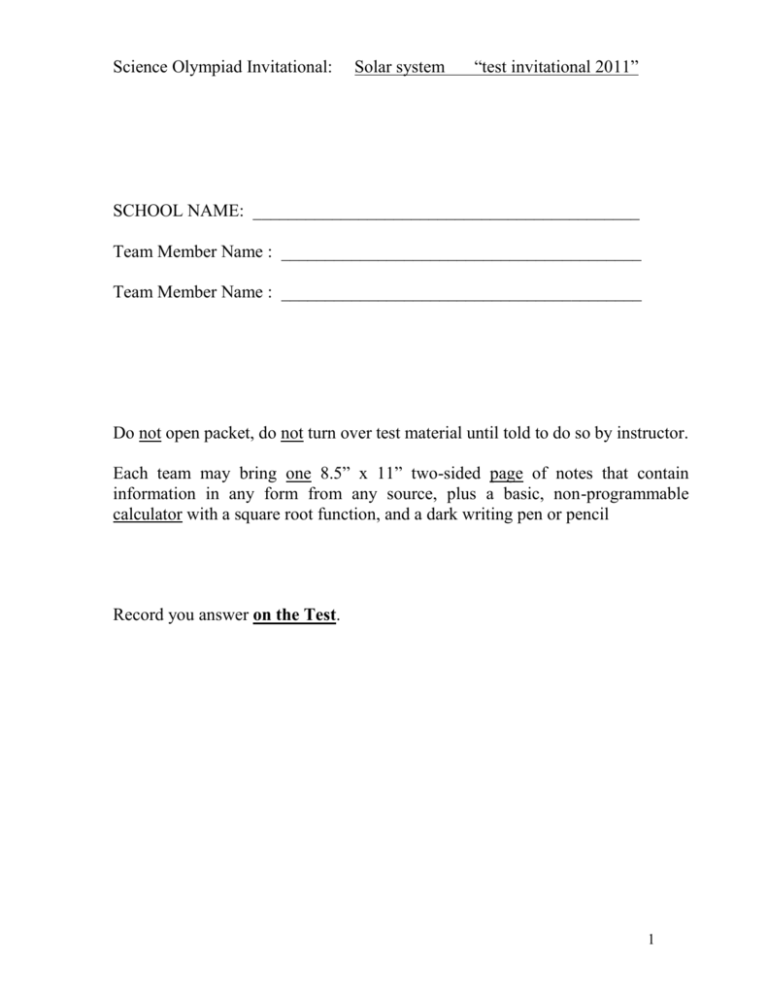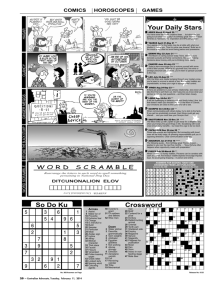Test - Scioly.org
advertisement

Science Olympiad Invitational: Solar system “test invitational 2011” SCHOOL NAME: ____________________________________________ Team Member Name : _________________________________________ Team Member Name : _________________________________________ Do not open packet, do not turn over test material until told to do so by instructor. Each team may bring one 8.5” x 11” two-sided page of notes that contain information in any form from any source, plus a basic, non-programmable calculator with a square root function, and a dark writing pen or pencil Record you answer on the Test. 1 1. Polaris is observed to be 20 degrees from your zenith, write in your location’s latitude? 2. The Sun is observed to not rise nor set on this day in June but circles our position at 23.5 degrees above our horizon. a. Where are you located on the Earth? b. What is the name of this event? 3. What phase of the Moon would it be, if we were on the Moon and observed a Full Earth? 4. State the location of the noon time Sun, in relation to the Earth’s surface, during Winter Solstice. 5. State the condition that happens two times a year when the Earth’s axis is perpendicular to the plane of revolution of the Earth/Sun orbit. 6. Regolith is made up primarily of what? 7. How was the Maria of the Moon created? 8. What features on the Moon are apparently the same age as the rays on the Moon? 9. Where on the Earth would you have to be, to have the Sun pass directly across your zenith at the time of the winter solstice? 10. What is one thing that all forms of electromagnetic energy have in common? 11. With stars of the same initial chemical composition, what determines the length of time it takes for a star to form, and the length of time that a star will exist? 2 12. In mid-northern latitudes, which phase of the Moon would you see if the Moon were rising at 6 p.m. while the Sun was setting? 13. Which position in the diagram below correctly shows Mars at opposition? 14. Which position in the diagram below shows Venus at conjunction? 15. What are Mascons, that are found on our Moon? 16. On January 3d the Earth was closest to the Sun, what is this point in its orbit called? 17. Explain how it is possible to see a partial Solar Eclipse of the Sun, while standing on the Earth. 3 18. Explain how the Moon is not completely darkened by Earth’s shadow during a total lunar eclipse. 19. How long will it take reflected Sunlight from Jupiter to reach us on Earth, if Jupiter is in opposition? 20. Why on the Earth, is the time period of one high tide till the next high tide about 12 hours and 45 minutes? 21. Why is Venus not seen at midnight? 22. An object is discovered orbiting our Sun at a distance of four Astronomical Units. How long will the objects period of revolution around the Sun be? 23. At what point in Earth’s orbit around the Sun, will the Earth be traveling the slowest? 4 24. If the Moon takes 27.3 days to complete one revolution around the Earth, why then does it take 29.5 days from one New Moon phase to another New Moon phase? 25. Mercury has a very large impact basin called the Coloris Basin, on exactly the opposite side of Mercury, where the shock waves all converged, is known as what? 26. What are the four large moons of Jupiter from the inside orbit to the outside orbit? 1st 2d 3d 4th 27. Saturn’s ring systems lie at about 2.44 radii from Saturn; this is well within a certain limit known as what? 28. Name the two things that allow a planet to remain in orbit with the Sun. a. b. 29. Under what conditions are you able to directly view the Sun’s corona? 5 30. If the Sun were suddenly to become a solar-mass black hole, what would happen to the Earth’s orbit? 31. Moons A, B, and C are in a resonance of 1:2:4 as they go around a planet. Explain what this means; compare the orbital speeds of the moons to each other. 32. The planet with the greatest rotational speed is _______________________ 33. As the distance from the Sun increases, the orbital period of the planets _______________ 34. How many Earths would fit across the Jupiter’s equator? __________ 35. How many Earths would fit across the Sun’s equator? ____________ 36. The least dense planet is ___________________ 37. The largest Moon in the solar system is ___________________ 38. The Moon most similar in size to Earth’s Moon is ______________________ 39. Why do the Moon and Mercury have no significant atmospheres, unlike the Earth? 40. If the radius of the Earth were to double, with no change in its mass, what would happen to a person’s weight? 41. If one could somehow turn off the gravity from the Sun, the Earth would do what? (Circle the most correct answer’s letter) A. Spiral outward from the Sun B. Travel in a straight line along its present velocity, perpendicular to a line connecting Earth and the Sun. C. Collide with the Moon D. Leave the Solar System along a line connecting the Earth and the Sun. 6 42. Describe a penumbral Lunar eclipse. 43. Describe the location of the Barycenter of the Earth/Moon system. 44. What is radial velocity? 7








